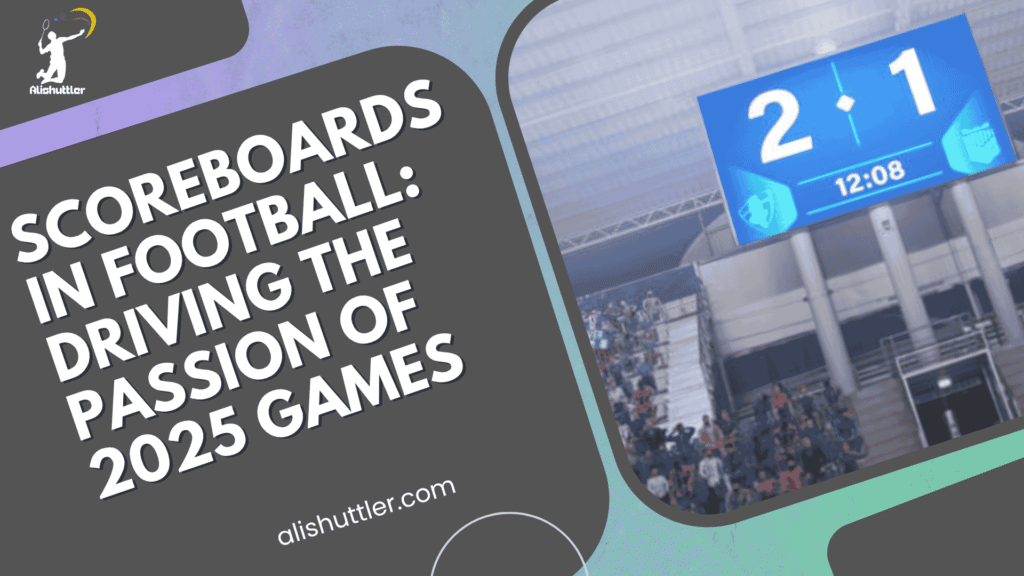Scoreboards in football provide the game score, time remaining and additional game statistics to supporters and players. They display things like team name, goals, fouls live!
New age scoreboards use digital displays for a prime view from any seat. Others display live stats, player statistics and instant replays.
To keep track of the game’s rhythm, it pays to know how to read these boards. The following sections detail major functionality and applications for supporters and teams.

The Core Function
A football scoreboard is the core of game information, serving as a vital scoring solution for fans, athletes, and coaches. It keeps everyone updated on the game action, status, and highlights. The primary responsibilities of a digital scoreboard include indicating scores, time, penalties, teams, and players, ensuring that football fans are up-to-speed on the match and contextualizing each play.
1. Displaying Scores
The core function of a scoreboard is to display the names or abbreviations of the two teams, and the score. This screen refreshes in real time after each touchdown, field goal, or other scoring play. Legible fonts and high-contrast colors ensure that fans in the uppermost tiers can spy the digits.
Some newer boards do more than just add the score. They have the list of scoring plays, who scored and when, and stats like goals and assists. This provides fans a better perspective on how the game unfolded and accentuates key moments that defined the contest.
2. Tracking Time
The match clock is the lifeblood of the scoreboard. It displays how much time remains in the current quarter or half and informs viewers of the game’s current stage. The board segments time by quarter, monitors injury time, and employs a countdown clock for overtime.
This assists coaches and players to make intelligent decisions, such as whether to accelerate the pace of play or run down the clock. A clean visual design with time bars or markers lets fans know how much play is left. The clock takes into consideration stoppages, keeping the timing fair and inline with the official rules.
Timeouts, possession and down indicators provide additional context for fans. If you see “TO GO: 7,” that means the offense needs to move seven more yards to earn a first down. The board points out the quarter, the current down and even what yard line the ball is on.
These particulars are crucial for devotees wishing to track the significance of every move. This scoreboard accounts for extra points, two-point tries, safeties, and field goals, so the score is always representative of every way a team can score.
3. Showing Penalties
Well, clear penalty displays help fans understand rule breaks. Boards display text and color codes indicating the type of penalty—yellow for offside, red for serious fouls. Team fouls are clearly enumerated, providing coaches and players a strategic risk management insight.
Penalty stat tables aggregate patterns, such as serial offenders or catching player discipline, for quick reference on all sides. Penalty info can turn the tides of a game, so boards display not only the penalty, but how it influences the down or field position. This is very handy in tight contests.
4. Identifying Teams
Team names and logos are displayed big and bold so you can easily see who’s on each side. Home and away markers take the guesswork out. Colors correspond to team kits, so supporters identify with their side immediately.
Supporters want to see their team’s emblem or colors at the stadium entrance. This easy reminder fosters camaraderie and personalizes the game. Short team names or abbreviations are helpful on smaller boards or for viewers with less time to scan the details.
Team branding isn’t just about aesthetics–it helps fans feel involved in the experience!
5. Announcing Players
Boards feature player names and numbers, giving faces to the on-field action. So when the rookie hits the floor, the board changes immediately — fans never miss a sub. Key stats, such as goals or assists, assist fans in identifying star players and tracking them.
Other boards display scrolling lists of player accolades or milestones, honoring attention grabbers and enriching the fan experience.
Beyond the Basics
Football scoreboards do more than keep score now. They combine tech, design and data to present every angle of a match. These massive displays allow fans, coaches, and players to stay on top of everything from the game clock to player stats to even instant replays.
Today’s scoreboards can extend the entire length of a sideline, utilizing LED lights for sharp images. A lot are remotely controlled to maintain info up to date. For optimal viewing, the audience needs to be a minimum of 3.5 feet from the screen per each 1mm of pixel pitch.
Scoreboards have grown to be essential stadium components, even generating revenue through advertisements and sponsorships.
The Other Time
Scoreboards display more than just standard game time. They, too, show stoppage time. This keeps us all aware of how much longer the game will continue, especially in close games.
There are obvious visual indicators showing injury time or delays. Or, when a player is down or there’s a break in the action, the scoreboard can flash an especial icon or highlight the additional minutes. That keeps fans informed and helps minimize uncertainty about when the match will conclude.
Certain football codes have timeouts or breaks. New-fashioned scoreboards record all these timeouts and onside kicks. This keeps the match flowing and helps fans keep up, even if the rules are unfamiliar to them.
Fans can utilize this data to examine how timeouts influence team momentum or strategy. A checklist for time stats can include: regular play time, added stoppage time, injury minutes, team timeouts, and total break duration. This simplifies identifying game flow trends and strategizing.
The Soccer Concept
In football, the scoreboard serves as a one-stop shop for everything that’s going on in the game. It doesn’t simply display objectives. It records assists, cards and substitutions. That simplifies it for fans and analysts trying to identify which players are making an impression.
Goals and assists are the important stats in any soccer game. Scoreboards show these live, so all can stay on top and see who’s leading the charge or supporting the team. It makes the watching experience more profound.
Most football scoreboards display league tables and tournament progress. This allows fans to understand the context of how their team is doing or what’s on the line in each game.
A few displays even update live, displaying points, rankings, or possible playoff matchups. Scoreboards can utilize graphics, icons or even brief highlight clips to indicate scoring opportunities. This aids fans in feeling how near their team was to scoring, not merely the outcome.
Technological Evolution
Football’s scoreboards have experienced massive transformations that influence how games are played and viewed. Originally, scoreboards were primitive manual devices, operated by hand and frequently difficult to decipher from afar. This all changed in the late 1930s when the first electric scoreboards emerged and began to gradually replace the manual variety.
These new electric boards utilized bulbs to display scores, enabling quicker, clearer updates. In the 1940s, incandescent lights made scoreboards brighter. By the 1970s, LED lights made them even more colorful, reliable, and easy to see – even in daytime or rain.
The late 20th century got digital scoreboards. They can display scores, game time and other basic stats. Taking it digital made it so much easier for everyone in the stadium to track the action. Less human error and updates were immediate.
Digital boards consumed fewer power and survived longer than previous ones. As this technology became more affordable, it was commonplace to find digital scoreboards in schools, local community fields, and venues of every size.
Video scoreboards began to appear in the 1990s and early 2000s, initially in large stadiums and then in smaller venues as prices fell. These video screens allowed fans to view live replays, slow motion and player statistics. They could display graphics, fan messages and even sponsor advertisements.
This made the fan experience more enjoyable and kept them involved, even during time-outs. For players and coaches, these scoreboards provided an opportunity to immediately review plays and to learn from in-game feedback. High schools now have LED video boards making it feel like a pro event to both players and fans.
They’re not just scoreboards anymore. They’re now integral to how the game is broadcast and distributed. Today’s boards can connect to social media, display fan polls and stream highlight reels.
That builds community and makes fans feel like they are in the middle of the action, wherever they may be. Newer tech like AR and AI could add even more layers down the line, like smart stats or interactive fan games. Scoreboards have evolved from tally board to the heart of the game-day experience, influencing the way we play, watch, and enjoy football.
Modern Design
Today’s football scoreboards, especially the new LED football scoreboard, are much more than just a basic scoreboard. They combine clean interfaces, crisp visuals, and interactive elements to enhance the way football fans view and engage with the game, making the game day experience truly unforgettable.
Key Components
Scoreboards require some essential components to function optimally. Displays, frequently massive LED or LCD screens, exhibit scores, player stats and even live video. Controls—either buttons or digital touch panels—allow employees to add information quickly.
Software is essential, allowing operators to adjust configurations, deploy varying layouts and control live updates from anywhere in the stadium. Power has to be rock solid, too – most systems these days are backed up with batteries or generators, to prevent an outage.
The demand for remote control is enormous. Custom software allows staff to update scores, initiate countdowns, or play instant replays without exiting the booth. A good scoreboard is simple to operate, so even fresh staff pick up the ropes fast.
Here’s a checklist for effective scoreboard design: bright and clear display, simple controls, secure power supply, user-friendly software, and easy maintenance access.
Display Technology
LED and LCD front-runners LED displays are the new choice of choice, providing bright colors, excellent energy efficiency and durability. LCDs can do the job as well, but they don’t compare with LED’s brilliance or size.

High-resolution displays allow fans to see from afar, even in arenas with screens more than 11 meters wide and 6 meters tall. Brightness matters—LEDs can shine in bright daylight or dim down at night. Modern screens can toggle modes for day or night games, keeping data easily readable at all times.
| Display Type | Brightness | Clarity | Cost | Durability |
|---|---|---|---|---|
| LED | High | High | Moderate | High |
| LCD | Medium | Medium | Low | Medium |
| Projection | Low | Low | Low | Low |
Environmental Proofing Scoreboards in Football
Outdoor scoreboards encounter rain, sun, wind and dust. Weather-resistant enclosures prevent moisture and dust intrusion. UV protection prevents screens from fading in direct sun, an important feature for outdoor football fields in hot or bright climates.
Rugged mounts and frames keep the Scoreboards in Football put, even during high winds or storms. A basic maintenance plan helps scoreboards last longer: check seals monthly, clean screens every two weeks, and test power backups before each season.
Patches for tiny bugs keep games cruising.
The Fan Experience
Scoreboards are more than just a basic football scoreboard in football; they define how football fans engage with the game, both in and out of the stadium. As stadium attendance falters and more fans follow along from home or their phone, the demand for interactive features like video scoreboards in Football increases. Well-crafted scoreboards in Footballenergize the crowd and redefine the live sports experience.
Fostering Engagement
Live polls and quizzes on Scoreboards in Football are fan favorites. These functionalities allow users to predict the results of matches, provide answers to questions about teams or players, and observe live scores. It’s an escape from spectatorhood and an avenue for fans to sculpt the moment.
Others display fan reactions and celebrations on the big screen, cultivating a feeling of camaraderie. It makes them feel noticed and as if they are on a team. When stadiums use scoreboards to advertise upcoming events or specials, additional fans have incentives to return.
- Show fan tweets or photos with hashtags on screen
- Run contests for best signs or cheers
- Highlight social media polls and display instant results
- Use QR codes for in-game surveys
- Feature messages for birthdays or special occasions
Providing Analytics
Real-time stats on Scoreboards in Football provide fans with player performance, team trends and key moments. These updates assist fans and analysts in following along with what’s transpiring on the field. We can display goals, passes, tackles, and even player speed on scoreboards – with simple visuals so all can engage.
Over time, teams utilize Scoreboards in Football data to identify trends and optimize future games. Dashboards on the board can display trends over matches, providing greater insights to both fans and teams. Fans expect immediate information now.
Since most watch with a smartphone or laptop nearby, having stats on the scoreboard keeps everyone in the loop and makes the in-person experience more valuable.
Creating Atmosphere
Nothing like a 21st-century scoreboard in Football to set the mood in a stadium. Big, premium screen with crystal-clear images that make moments pop, be it a last-minute winner or a crucial replay. Music, sound effects, and synchronized lights all contribute to the experience.
When the Scoreboards in Football features celebrations or fan shots or dramatic moments, it ignites the crowd energy. These elements allow stadiums to be competitive with home viewing. Instant replays, hype videos and team animations keep fans involved throughout the game.
In a universe where fans are perhaps more attached to their screen than their seat, these devices make the experience of the live game magical.
A few key Scoreboards in Football features for atmosphere:
- Fast replays Scoreboards in Football
- Animated team logos
- Goal and highlight countdowns
- Crowd noise prompts
Operational Realities
Scoreboards in football, especially the new LED Scoreboards in Football, are way more than just displays; they serve as essential scoring systems that record time, scores, game stats, and even sponsor messages. The operational realities of these digital scoreboards include maintenance, employee education, expenses, and hard regulations.
Maintenance
Maintaining a scoreboard in Football operation requires a regular regimen. Every component, from LED lights to control panels, should be inspected pre- and post-matches. Small glitches, such as a jammed finger or flickering light on the digital scoreboard, can spoil the game. Regular inspections catch these early.
Teams need to know how to identify and resolve fundamental issues in their football scoring systems. Typical problems involve power loss, bad connections, or programming errors. Training teaches teams how to solve these problems quickly, reducing delays during matches.
Each action in maintenance cleaning, wire checking, and software updating should be documented in a manual. This allows staff to easily take the same steps each time. A checklist keeps it on track, ensuring you don’t miss a thing, from testing displays to checking for loose bolts and worn cables.
Regulations
You see, that’s how scoreboards are supposed to work. These encompass the luminosity of screens, the data they present, and the speed of transitions. Safety regulations shield employees, supporters, and athletes from defective cables and monitors.
Teams have to adhere to league guidelines regarding which stats to display and the timing thereof. For instance, certain football boards have to show yellow and red card counts. Others require automatic timers for fair play.
Not following these rules can equal fines or bans. All the important rules should be summarized by venue for staff to reference when configuring or operating the scoreboard.
Logistical Challenges on Scoreboards in Football
Establishing and operating a scoreboard is complicated, particularly for international competitions. The bigger the stadium, the more difficult it becomes. Older venues, on the other hand, still rely on manual boards, with employees physically swapping out numbers. This risks drag and it leaves error space.
In today’s stadiums, electronic boards require reliable power with backups, especially when storms blow in or fans become unruly. Transitioning to LED Scoreboards in Football does assist with speed and clarity, but they require skilled operators.
These boards can show much more, even ads and real-time stats, but any typos or lags everyone sees.
Costs
Scoreboards are a big expense for teams and venues. Contemporary Scoreboards in Football, particularly LED-based ones, can easily reach the millions of dollars. Upgrades, repairs, software updates and staff training pile on to the bill.

If you want to keep costs down, that implies scheduling regular maintenance and using checklists to prevent major repairs. Sponsorship and ad space on boards can help offset these expenses, transforming the scoreboard into a revenue generator.
Final Thoughts
Scoreboards define every game, from the opening kick to the final whistle. Fans look up to check the score, or see the clock, or a replay. Scoreboards establish the atmosphere, provide instant statistics and assist fans to remain in the moment. Clocks and scoreboards count on them to keep play fair and clear. Stadiums choose new tech for crisp displays and simplified updates.
Each scoreboards-in-football upgrade gets fans closer to the game. Scoreboards don’t just keep scores anymore they keep the speed, the stats, even the faces in the crowd. To stay up with the game’s pace, innovation and new looks count. For all you folks who want football to continue its upward trajectory, watch the scoreboard next time!
Frequently Asked Questions
What is the main purpose of a scoreboard in football?
A football scoreboard displays the score, time, and other crucial information in a football game, enhancing the game day experience for fans, players, and referees.
How have football scoreboards changed over time?
Scoreboards have evolved significantly from basic scoreboards to advanced digital scoreboards, offering live updates, game stats, and video replays for an enhanced football game experience.
What features do modern football scoreboards offer?
Modern video football scoreboards display scores, timers, player statistics, and instant replays, enhancing the game day experience.
How do scoreboards improve the fan experience?
Scoreboards, especially the new LED football scoreboard, keep fans informed with live scores, statistics, and highlights, enhancing the game day experience for everyone in large stadiums.
Are there differences in scoreboard design around the world?
Yep, scoreboards are regional and stadium specific. Most are digital and international standards for readability and accessibility.
What operational challenges do stadiums face with scoreboards?
Stadiums require dependable, weather-resistant scoreboards, such as a new LED football scoreboard, that are easy to maintain while providing real-time game stats.
How do scoreboards contribute to fair play in football?
Scoreboards, including the new LED football scoreboard, transparently display accurate game information, promoting confidence among football fans and participants.






